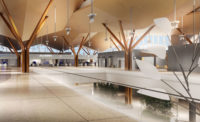

Expected to open in June, Berlin Brandenburg International Airport, a single new, robust air hub for Germany's capital, is nearing completion. Located 18 kilometers southeast of the city center, it will incorporate one runway from Schonefeld Airport, the smaller of Berlin’s two existing airports.
The new hub will have an initial capacity of 27 million passengers per year, which will make it Germany’s third-busiest airport, behind Frankfurt (47 million) and Munich (32 million). Its design calls for two additional satellite terminals to be added in the future, which will eventually bring its capacity to 45 million. While Schonefeld was 500 hectares, Berlin Brandenburg is almost triple in scale, at 1,470 hectares. Construction is expected to cost $4.4 billion.
Beginning in late 2007, Schonefeld’s southern runway was extended to 3,600 meters from 3,000 meters and will serve as Brandenburg’s northern runway. A new, 4,000-m runway has also been built to the south of the main terminal. A new, stark-looking control tower, 72 m tall, was completed in October 2010.
The new terminal was designed by Generalplanungsgesellschaft mbH and JSK International Architekten and Ingenieure mbH. It will contain 220,000 sq m of floor space and 25 gates, with five floors above ground and two underground levels for S-Bahn train service.
One of Europe’s biggest mobile cranes—the so-called Red Giant, a Liebherr LR 1750—"was employed until spring 2010 to lift the roof elements," said Leif Erichsen, spokesman for Flughafen Berlin-Schonefeld GmbH, the airport operator.
Currently, a construction workforce of 5,500 is working to complete the interior of the terminal as well as the new train station at Wassmannsdorf.
During and after the Cold War, Berlin was served by three airports: Schonefeld in East Berlin and Tegel and Tempelhof in West Berlin. Tempelhof closed in 2008 and will be redeveloped into an 400-hectare public park. Tegel, built in a hurry in 1948 to handle much of the Berlin airlift traffic, will close on June 3 as Brandenburg opens; it will be converted into a business park.



Post a comment to this article
Report Abusive Comment